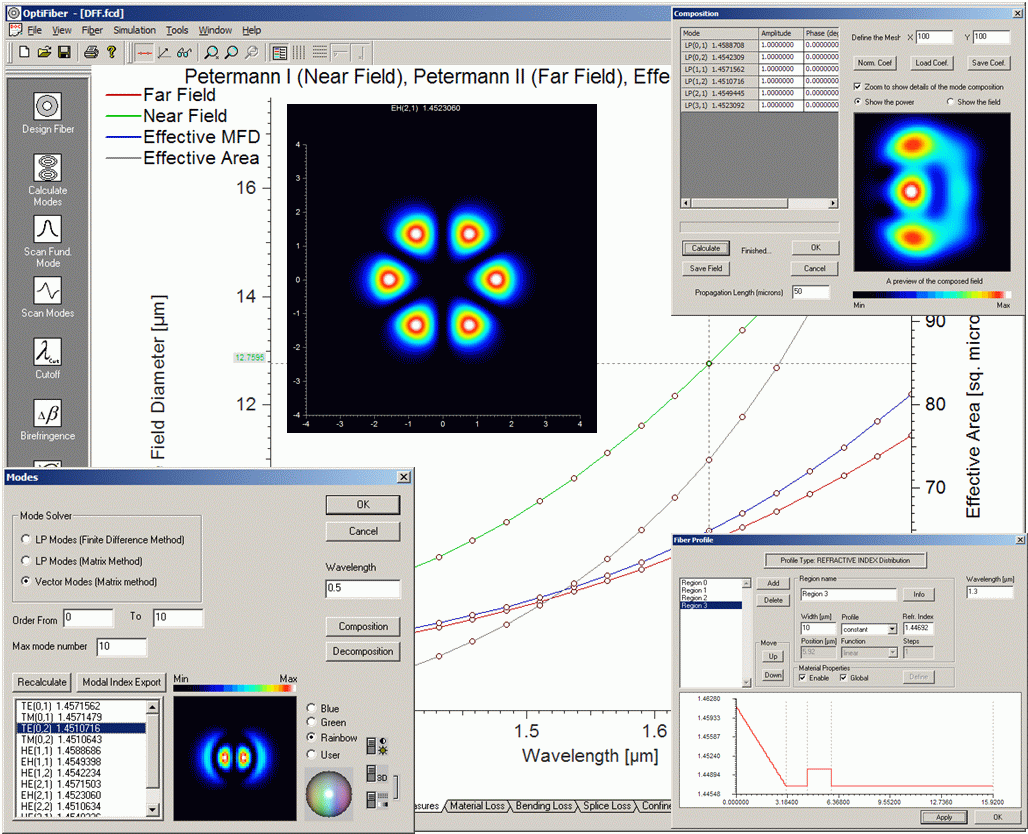Contents

Source: Optiwave
Understanding Fiber Optic Devices: Simulation and Applications
Introduction
Fiber optic technology has become an integral part of modern communications and laser systems. The design and development of both passive and active fiber optic devices can be intricate and require sophisticated numerical tools for effective analysis and optimization. This blog post explores various aspects of fiber optic devices, including mode calculations, beam propagation, optical amplification, and ultrashort pulse propagation.
Simulations in Fiber Optics
Simulations play a crucial role in the design of fiber lasers, amplifiers, and pulse compressors. They help in understanding the physical details required for optimizing fiber components. The calculation of fiber modes, particularly guided modes, is essential for tasks such as light coupling and determining the beam quality of the output.
Calculation of Fiber Modes
Guided modes are determined by the refractive index profile of the fiber. Most all-glass fibers have a radially symmetric profile and weak index contrasts, allowing for simpler numerical methods. However, more complex fibers like polarization-maintaining and photonic crystal fibers require advanced algorithms due to strong index contrasts.

Numerical Beam Propagation
In certain cases, calculating fiber modes is not feasible or helpful. For example, in pump claddings of double-clad fibers with irregular profiles, beam propagation models are more suitable. These models can handle various geometries and conditions, offering insights into how light behaves within the fiber.
Optical Amplification in Fibers
Optical amplification is a key process in fiber lasers and amplifiers, typically using rare-earth-doped fibers. The behavior of laser-active ions and the resulting gain are influenced by mode properties and the overlap with the dopant.
Behavior of Laser-active Ions
Rate equation modeling describes the interaction of laser-active ions with the light field. For accurate modeling, various spectroscopic data such as transition cross-sections and upper-state lifetimes are required. These models help in optimizing fiber designs for specific applications.
Laser or Amplifier Gain
The laser gain depends on the excitation density of ions and the overlap with fiber modes. Higher-order modes can be designed to have lower gains than fundamental modes, optimizing the performance of the fiber device.
Dynamic Simulations
Dynamic simulations focus on the temporal evolution of fiber devices, such as amplifiers and Q-switched lasers. These simulations account for time-dependent power inputs and help in understanding complex behaviors like gain saturation and pulse distortion.
Ultrashort Pulse Propagation
Ultrashort pulses are crucial in various applications, and their propagation in fibers involves considering chromatic dispersion and nonlinearities. Simulations help in designing mode-locked fiber lasers and understanding pulse propagation in passive fibers.
Case Study: Nonlinear Pulse Compression
Nonlinear pulse compression techniques involve broadening light pulses through self-phase modulation and compressing them with dispersive elements. These methods can significantly reduce pulse duration, enhancing the performance of fiber devices.
Conclusion
Fiber optic devices are complex systems that require detailed analysis and simulation for effective design and optimization. By understanding the various aspects of fiber mode calculations, beam propagation, optical amplification, and ultrashort pulse propagation, engineers can develop more efficient and powerful fiber optic systems.

Source: RP Photonics
Feel free to comment your thoughts.



